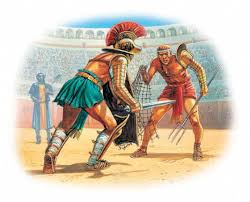Roman gladiators were special in their day -- that being between 100 BC and 200 AD.
to some, gladiators
were uncivilized brutes, armored barbarians, treacherous and degenerate.
to others, they
were the rock stars of their day, the star athletes of their day, entertainers,
celebrities and even sex symbols.
as reported "the
gladiators won massive fame among the lower classes. Their portraits graced the
walls of many public places; children played with gladiator action figures made
of clay; and the most successful fighters even endorsed products just like the
top athletes of today. They were also renowned for their ability to make Roman
women swoon. Graffiti from Pompeii describes one fighter who “catches the girls
at night in his net” and another who is “the delight of all the girls.” Many
women wore hairpins and other jewelry dipped in gladiator blood, and some even
mixed gladiator sweat—then considered an aphrodisiac—into facial creams and
other cosmetics."
with this as background, and being in Rome, the Tuscan Trio
could not resist doing a couple of things.
first and foremost, visiting the Colisseum, the place where
the gladiators performed. they performed three times during the
day. the morning was focused on wild
animals. noon time was for
executions. and then the afternoon
focused on hand to hand combat between the gladiators.
second, we went to Gladiator School this morning. the outcome of which was graduation from the
only gladiator school still in existence (at least to our knowledge). we received honorary Roman citizenship. and, perhaps
most importantly, we received our gladiator names.
PJ, for example, is known as Maximus as a gladiator. Tom is known as Bacchus. Yours truly is known as Augustus.
the point that needs clarification
is why do we have an interest in being trained as a gladiator in today's world.
first, we are assuming that gladiators, regardless of their
previous reputation, can do good in this world.
what once was seen as brutal, bloody and barbaric, can somehow be turned
around to be gladiators who are gifted, giving
and generous.
second, as you are aware, we have become enthralled with the
concept of the Renaissance man. in history, one of
the key components of a Renaissance man was his capability in war --
specifically, hand to hand combat.
we realize that this is not quite like other components of a Renaissance man -- for example, being able to sculpt,
or to read Latin, or to cook sumptuous Italian dishes.
Nevertheless, we believe that having gladiator training cannot be anything but
helpful in our effort to become Renaissance men.
who knows, in this day and age, when gladiator training may come in handy.
and, one thing is for sure, very few men have been trained as gladiators.





No comments:
Post a Comment